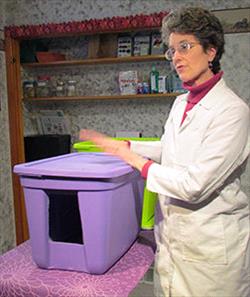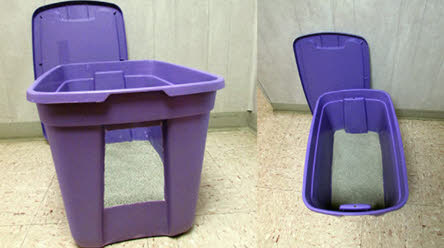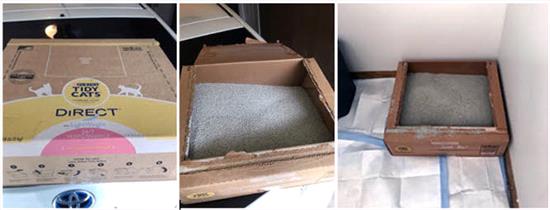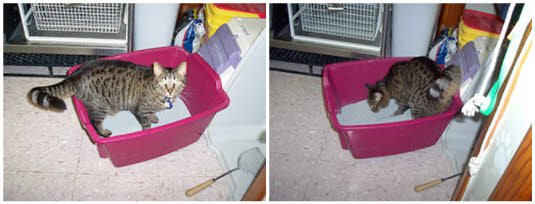As a Veterinarian I am often surprised by how infrequently clients will ask about their cat who is not depositing their stool or urine in the litter box. I have learned over the many years I have been in practice to ask specifically if the cat is getting all the waste in the box. Often clients say: “He goes most of the time, but then he really aggravates me by urinating right next to the box. He is such a pain,” or “He is just ornery and won’t use the box for his stool. He goes nearby and since it is easy to pick up it is not a problem.” So, this is not a big problem for the owner, but the cat is not happy with their litter box. I have discovered many cats for whom diabetes, early kidney failure, and other health problems were the cause of them missing the box. I have written blog posts in the past about the various health problems that can cause inappropriate elimination. In this post, I will focus on the various home issues that can cause a cat to urinate or defecate right next to the box.
One of the most frustrating scenarios is one where urine or stool is within 6 inches of the sides, back or front of the litter box. In short, right next to the box, but not in the box. So aggravating! The cat is 90% of the way there but fails to go in the box. What’s up?
Here are three of the most common scenarios for “missing the box:”
Your cat may not be able to assume the correct position in the litter box. The posture they need to assume is one with the rear end tucked under far enough so everything lands in the box. Many commercially available litter boxes are too small for a cat to climb in, sniff around, paw, and crouch with room for the tail to not be bumped up against the back of the box. Litter boxes need to be 1 ½ times the length of the cat’s body and about 3 times as wide as the cat. Many of our cats are obese and have a tough time tucking enough to have their rear in the right place. So, the cat gets in position, but the rear end is hanging over the edge and the stool or urine ends up on the floor next to the box. The cat was in the right place and doing the right thing, but the box is the problem. Under the bed storage boxes are large enough and low sided enough to help with this problem. Creating a new litter box out of a large storage bin can also help. See my YouTube video to make one yourself.
You may also try the disposable litter boxes available online. These are shipped to you regularly with litter. Many of these boxes are large and the new box does not have past odors that may be undesirable for the cat.
Your cat may be doing a balancing act of getting in the box, but stands on the edge of the box rather than in the litter while the urine or stool shoots over the edge. Watching your cat balance on the edge of a litter box may seem comical or weird, but it is a sign that the cat does not like standing in this box or is not able to, possibly because it is too small. If you have a large box and your cat is standing on the edge, this often means the cat does not like the actual litter. This may be due to deodorizers, plastic liners, the non-clay type litters, or post declaw pain. Try offering your cat a second box with a different type of litter and see which one it prefers. The litters most widely accepted by cats are the generic clay litter or the litter with only activated charcoal as the deodorizer. Post-declaw pain can be low grade and chronic; the cat may be walking fine, but avoids jumping up or down and is typically sensitive about petting near the legs. If there has been a chronic problem with your cat avoiding the litter and you have tried alternate types and larger boxes, have your cat examined and discuss joint supplements and low-dose meloxicam therapy for your cat with your veterinarian.
Your cat is constipated. They get in the box, they get in position, but nothing happens. After a while of no results, they get out of the box. Now the stool is right there and they must go NOW. So, they do. Only it’s just near the box, not in the box; whereas on good days, they may get the stool in the box. This can be a very perplexing problem. Refer to the stool chart by Royal Canin. The small broken up stool is constipation in the cat (Score 4.5 & 5 on the chart for cats). You want to see “tootsie rolls” that are 3–4 inches long. Constipation problems may be due to a lack of fiber, not enough water consumption, irritable bowel disorder, or possibly kidney failure. If your cat has firm stools, please have your cat examined and bring stool samples and photos of your cat’s stool. Veterinarians are used to looking at all sorts of things, so don’t feel weird about bringing photos of your cat’s litter box. It can help a lot with diagnosis.
You may do all these things and your cat might still go right next to the box. This can be aggravating, to say the least. If you have worked with your veterinarian to screen for health problems or any chronic pain, there are ways to help manage this behavior and keep your home clean, such as putting a puppy pad under the litter box to catch the misses. Now you can dispose of the waste and it will not soil your home. Clean the floor with an enzyme cleaner to remove as much of the odors as possible. Whenever you find your cat near the box praise and reward them. Even if your cat is going in the box 50% of the time, they may improve with a larger box, good litter box hygiene, and their favorite type of litter.
For Further Reading:
- The On Again/Off Again Litter Box User – Feline Idiopathic (Interstitial) Cystitis
- Litter Box Happiness – For Cats of All Ages
- Litter Box Problems Could Be Due to Physical Ailment
- Covered or Uncovered Litterboxes: Do Cats Have a Preference?
- What to Do When Your Cat Poops Outside the Box






